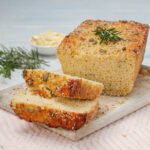Chickpea Bread
A fluffy, gluten-free bread made from chickpeas.
Servings: 8
Ingredients
- 2 cans 15 oz each chickpeas, drained and rinsed (about 3 cups or 500 g)
- 2 large eggs
- ½ cup skim milk 120 ml
- 1 tablespoon fresh rosemary finely chopped (or 1 teaspoon dried)
- 2 ¼ teaspoons active dry yeast 1 packet or 7 g
- ½ teaspoon salt
- 1 teaspoon olive oil for greasing the pan
Instructions
- Drain and rinse the chickpeas thoroughly. This removes excess sodium and helps achieve a smoother texture in the final bread.
- Blend wet ingredients: In a high-powered blender or food processor, combine the drained chickpeas, eggs, and milk. Blend on high speed for 2-3 minutes, stopping to scrape down the sides as needed, until the mixture is completely smooth and no whole chickpeas remain.
- Season the dough: Transfer the chickpea mixture to a large mixing bowl. Add the chopped rosemary and salt, stirring to combine.
- Activate the yeast: In a small bowl, mix the yeast with 1/4 cup of warm water (about 110°F or 43°C). Let it sit for 5 minutes until it becomes frothy, indicating that the yeast is active.
- Fold in the yeast: Gently fold the activated yeast mixture into the chickpea batter using a spatula.
- Proof: Cover the bowl with a damp cloth and let the batter rest in a warm, draft-free place for 30 minutes. The mixture should rise slightly and become a bit bubbly.
- Preheat: While the batter is resting, preheat your oven to 350°F (175°C) and lightly grease a 9x5 inch loaf pan with the teaspoon of olive oil.
- Mold the loaf: After the resting period, give the batter a gentle stir and pour it into the prepared loaf pan.
- Bake for 45-50 minutes, or until the top is golden brown and a toothpick inserted into the center comes out clean.
- Let cool: Remove the bread from the oven and let it cool in the pan for 30 minutes. Then, carefully remove it from the pan and allow it to cool completely on a wire rack before slicing.
- Slice and serve: Once cooled, slice the bread into 8 even pieces. The texture will be denser than traditional wheat bread, but it should have a moist crumb and a slightly nutty flavor from the chickpeas.
Notes
1 WW point per slice.
Nutrition
Serving: 94g | Calories: 121kcal | Carbohydrates: 16g | Protein: 7.2g | Fat: 3.6g | Saturated Fat: 0.6g | Cholesterol: 47mg | Sodium: 471mg | Potassium: 138mg | Fiber: 4.5g | Sugar: 3.4g | Calcium: 56mg | Iron: 138mg
